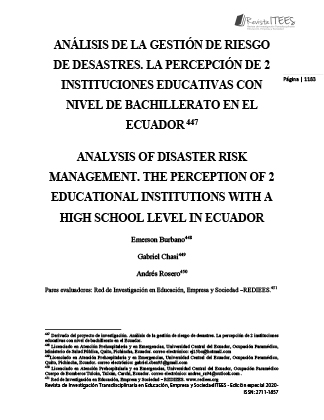LXII. ANALYSIS OF DISASTER RISK MANAGEMENT. THE PERCEPTION OF 2 EDUCATIONAL INSTITUTIONS WITH A HIGH SCHOOL LEVEL IN ECUADOR
##plugins.themes.bootstrap3.article.main##
Abstract
The objective of the research was to determine how the institutional management of disaster
management is perceived and the relationship between age and the effectiveness of
institutional emergency plans in two educational institutions with a high school level in
Quito-Ecuador. Methodology: qualitative-quantitative, non-experimental, cross-sectional,
exploratory research on a voluntary sample of 607 people to obtain data using a selfadministered questionnaire. Results: the population is divided into 43% men and 57%
women. The main threats to which it is considered exposed are earthquakes (75%) and crime
(79%), these generate a "High" degree of concern, they consider that their effects could
intensify over time and will be related to the human activity. 56% know the emergency plan
that the institution has, but 74% of them consider that these plans contribute to improving
institutional response capacities. By correlating the variables, it was determined that there is
a relationship between age and considering emergency plans to be effective in reducing
disaster risks. Conclusion: the construction of a culture for risk prevention requires the
highest degree of collective participation of all its social actors so that, through the resources
available, they can improve their response capacities in the face of emergencies and disasters.
Download Statistics
##plugins.themes.bootstrap3.article.details##
evacuation, risks, threats, disasters, perception
Caballero Lopez, J. E. (09 de 2009). http://scielo.isciii.es. Obtenido de
http://scielo.isciii.es/pdf/mesetra/v55n216/revision.pdf
GRUPO BANCO MUNDIAL. (14 de ABRIL de 2020). BANCO MUNDIAL. Recuperado el
28 de MAYO de 2020, de BANCO MUNDIAL:
https://www.bancomundial.org/es/topic/disasterriskmanagement/overview
John, A. (2016). Normas Basicas de Higiene del Entorno en la atención sanitaria. India:
Organizacion Mundial de la Salud. Obtenido de
http://apps.who.int/iris/bitstream/handle/10665/246209/9789243547237-
spa.pdf;jsessionid=98A5D7C69806F077F4D7F5B862DCA0BB?sequence=1
Ministerio de Ambiente y Desarrollo Sostenible. (17 de Julio de 2020). Minambiente.
Recuperado el 20 de Julio de 2020, de Minambiente:
https://www.minambiente.gov.co/index.php/gestion-del-riesgo-de-desastres
Ministerio de Educación. (2018). Gestion de Riesgos del Sistema Educativo. Obtenido de
Gestion de Riesgos del Sistema Educativo: https://educacion.gob.ec/gestion-deriesgos/
Ministerio de Educación del Ecuador. (2019). Plan Nacional Para La Reducción De Riesgos
De Desastres En Educación. Obtenido de Plan Nacional Para La Reducción De
Riesgos De Desastres En Educación: https://educacion.gob.ec/wpcontent/uploads/downloads/2019/11/Plan-Nacional-para-la-Reduccion-de-Riesgosde-Desastres-en-el-Sistema-Educativo.pdf





